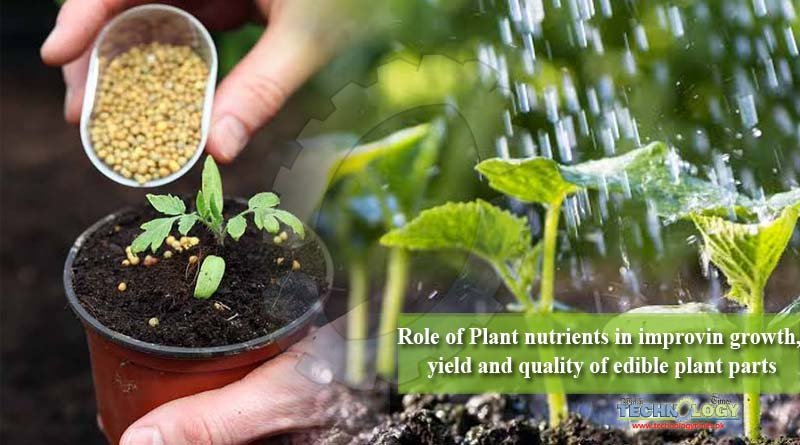Authors: Mehwish Nadeem1, Dr. Zubair Aslam2, Sami-ur-Rehman2, Ali Ahmad2, Muhammad Waqas2
1 Department of Botany, University of Agriculture, Faisalabad
2 Department of Agronomy, University of Agriculture, Faisalabad.
Plant growth mainly depends upon the nutritional status of the medium in which it is grown.

Successful crop production needs knowledge and skills from the preparation of soil to the harvesting of the crop. This knowledge should be from reliable sources.The constructive effect of adding nutrients to the soil for improving plant growth has been known for >2000 years. Soil and nutrients characteristics are the major factors that control the growth of plants. Appropriate nutrient supply and soil conditions are significant for grain’s quality and production. In current agriculture practice, fertilization is a key management practice that remarkably affects soil properties and nutrient supply such as soil salinity, porosity, and pH.
Arnon and Stout (1939) proposed a “term essential mineral elements”. Following criteria was set the mineral element to be an essential nutrient
- A plant must be incapable to complete its life cycle without that particular mineral element.
- The function of one element must not be replaced by another element.
- The mineral element must be involved in plant metabolism.
Major Functions of Essential Nutrients
Plant growth and development needs various nutrients. The essential macro-nutrients for lower plants include nitrogen, phosphorus, potassium, sulfur, and magnesium. However, iron, manganese, zinc, and copper, etc. are essential micro-nutrients for the plants. The major functions of all these essential nutrients are explained below.
The major applications of macronutrients in grapevine production, including potassium (K), nitrogen (N) and phosphorus (P), have been studied in many previous kinds of research.
1-Role of Nitrogen
Firstly, nitrogen is required in large quantities for proper growth and development. Secondly and most importantly, nitrogen is part of the chlorophyll molecule, which gives plants their green color. Thirdly, it is involved in creating food for the plant through photosynthesis. Nitrate is a form of nitrogen that plants mostly take from the soil in the form of a solution. Nitrogen fertilizer demand increases because plants require nitrogen in more concentration. The increase of nitrogen fertilizer increases the nitrogen level in soil solution. The current agriculture practice is to supply the nitrogen as a fertilizer. It also aimed to economize on application costs by making a single application to meet the demands of the crop for the entire season.
Role of Phosphorus
Phosphorus is very important for the healthy growth and development of the plant. It is associated with certain growth factors such as improved flower formation, seed production, and stimulated root development. Phosphorus also supports development throughout the entire life cycle, increased stalk and stem strength. It play role in earlier crop maturity, increased N-fixing capacity of legumes, improvements in crop quality and resistance to plant diseases.
Role of Potassium
Potassium is a vital plant nutrient. It is mandatory in huge amounts for normal development and reproduction of plants. It affects the plant size, color, shape, taste and other measurements attributed to healthy yield. For example, K fertilizer applications is a major measure to ensure the sweetness and fragrance of grapes. During photosynthesis, potassium controls the opening and closing of stomata. It plays an important role in the production of ATP (adenosine triphosphate) which is an important energy source. Potassium activates the enzymes used in many biochemical reactions.
Role of Zinc
Zinc (Zn) is a plant micronutrient which is required in small quantity but play a vital role in plant growth. In plants, zinc ranges from 15-60 ppm. In artificial growth medium, zinc ranges from 0.10-2.0 ppm. In plants, zinc is an important component of many proteins and enzymes. It is essential for internode elongation and hormone production. The most common micronutrient deficiency in plants is zinc deficiency. It causes extensive yield losses and health problems such as nutrient deficiency and affects the quality of the crop. Before the appearance of deficiency symptoms, its deficiency may cause 20% yield loss which is a severe threat to crop. Initially, zinc deficiency appears in middle leaves. During plant growth and production, every micronutrient plays a vital role. For example, Zn is a major element for the production of plant hormones and enzymes. Zn is responsible for grapevine production and differentiation.
Role of Boron
Boron is a plant micronutrient that is not required in large quantity but its deficiency causes extensive growth problems. Its deficiency did not cause chlorosis that is why it is different from other plant micronutrients. During cell wall synthesis boron play a major role with calcium and important for cell division.
Mn and Cu are responsible for photosynthetic and plant metabolic functions, that play an important role in the grape quality and production.
Plants intake essential nutrients through root hairs from the soil in solution form. Roots never take nutrients in solid form. Cation exchange is a pathway through which plant intake nutrients from the soil. With the help of proton pumps, root hairs pump the hydrogen ions into the soil. These hydrogen ions replace cations connected to negatively charged soil particles so cations are free for roots to intake.
Conclusion
To sum up, the plants are immobile and they frequently face nutrients deficiency in their surrounding environment, they utilized mechanisms to acquire macro- and micro-nutrients for their appropriate growth and reproduction. These nutrients (macro and micro) are very necessary for the completion of the plant life cycle. So, these play a major role in crop production.
